
PLASMA CHEMISTRY AND PLASMA PROCESSING
Scope & Guideline
Connecting Researchers to the Pulse of Plasma Technology
Introduction
Aims and Scopes
- Plasma Chemistry and Reaction Mechanisms:
The journal explores the fundamental chemistry involved in plasma processes, including the formation and behavior of reactive species, energy transfer mechanisms, and reaction kinetics. - Material Processing and Synthesis:
Research on the application of plasma technology for the synthesis and modification of materials, including nanoparticles, thin films, and advanced composites, is a core focus. - Environmental Applications:
The journal emphasizes the use of plasma technology for environmental remediation, including the degradation of pollutants, waste treatment, and the development of sustainable processes. - Biological and Medical Applications:
Research that investigates the interactions of plasma with biological systems, including antimicrobial effects, cancer treatment, and biocompatibility, is prominently featured. - Agricultural Innovations:
The journal covers the application of plasma technology in agriculture, particularly its effects on seed germination, plant growth, and pest control. - Theoretical and Computational Studies:
Theoretical insights and computational modeling studies related to plasma behavior and its interactions with various materials and species are also integral to the journal's scope.
Trending and Emerging
- Plasma Activated Water (PAW):
The use of plasma activated water for various applications, including agricultural and medical uses, is gaining increasing attention due to its demonstrated efficacy and versatility. - Plasma-Catalysis Hybrid Processes:
Research on the integration of plasma technology with catalytic processes is trending, focusing on enhancing reaction efficiencies for chemical synthesis, including methane reforming and CO2 conversion. - Non-Thermal Plasma in Agriculture:
The application of non-thermal plasma for enhancing seed germination, plant growth, and disease control is emerging as a significant area of research, driven by the need for sustainable agricultural practices. - Antimicrobial Plasma Treatments:
The exploration of plasma treatments for antimicrobial applications, particularly in medical and food safety contexts, is becoming increasingly prominent, reflecting public health priorities. - Computational Modeling of Plasma Processes:
There is a growing trend towards using advanced computational models to simulate plasma processes, allowing for better understanding and optimization of plasma interactions in various applications. - Environmental Remediation Technologies:
Increasing focus on the use of plasma technology for environmental cleanup, including the degradation of persistent organic pollutants and greenhouse gas reduction, is emerging as a critical area of research.
Declining or Waning
- Traditional Plasma Etching Techniques:
Research related to conventional plasma etching techniques has decreased, possibly due to the rise of more advanced and efficient methods that exploit newer plasma technologies. - Low-Temperature Plasma Applications in Industrial Processes:
The interest in low-temperature plasma applications in large-scale industrial processes appears to be waning, as researchers shift towards integrating plasma with other technologies for enhanced efficiency. - Thermal Plasma Studies:
The focus on thermal plasma processes, particularly in material synthesis, has seen a decline, with more emphasis now placed on non-thermal and atmospheric pressure plasma applications. - Niche Applications in Specific Industries:
Areas such as plasma applications for niche industries, like specific textile treatments or traditional food preservation, are becoming less frequent, indicating a shift towards broader applications with higher impact.
Similar Journals
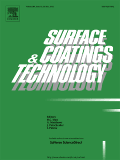
SURFACE & COATINGS TECHNOLOGY
Driving Innovation in Chemistry and Materials ScienceSURFACE & COATINGS TECHNOLOGY is a premier academic journal that has been at the forefront of research and innovation since its inception in 1986, diligently published by Elsevier Science SA. With an impressive range of studies focusing on surface and coatings technologies, the journal has established itself as a leading platform within the fields of Chemistry, Condensed Matter Physics, and Materials Science. Notably, it holds a distinguished Q1 ranking in multiple categories, showcasing its relevance and high impact in the academic community. Furthermore, it is recognized for its rigorous peer-review process and is indexed in esteemed databases, maintaining its strong position with a ranking of #17 in Surfaces, Coatings, and Films. Although the journal does not currently offer open access options, it continues to be a crucial resource for researchers, professionals, and students seeking insights into cutting-edge developments and applications in the domain of surface engineering. With a commitment to advancing knowledge across these disciplines, SURFACE & COATINGS TECHNOLOGY is an essential read for anyone interested in the latest trends and technologies shaping the industry.

Solid Fuel Chemistry
Illuminating the Path to Cleaner Energy SolutionsSolid Fuel Chemistry is a pivotal journal published by PLEIADES PUBLISHING INC, dedicated to advancing knowledge in the fields of chemical engineering, chemistry, and fuel technology. With its ISSN 0361-5219 and E-ISSN 1934-8029, this esteemed publication has been contributing to the scientific community since its inception, covering extensive research from 1975 to 2024. Operating within the Q3 and Q4 quartiles, it holds a significant position among peers in its categories, ranked 94th in Energy & Fuel Technology and 212th in General Chemical Engineering. Although it lacks an open access option, the journal remains a vital resource for researchers, professionals, and students eager to explore innovative developments in solid fuels and their applications. The articles published in Solid Fuel Chemistry provide essential insights, facilitate collaboration, and inspire further research, making it an indispensable platform for anyone engaged in this essential field of study.

Nuclear Materials and Energy
Empowering Knowledge in Nuclear Science and MaterialsNuclear Materials and Energy is a premier open-access journal published by Elsevier, dedicated to the dynamic fields of nuclear science and materials engineering. Since its inception in 2015, the journal has made significant strides in disseminating cutting-edge research, establishing itself as a vital resource for researchers and professionals alike. With a commendable impact factor and ranked in the Q2 category for both Materials Science (miscellaneous) and Nuclear and High Energy Physics, and impressively in Q1 for Nuclear Energy and Engineering in 2023, Nuclear Materials and Energy stands out in the academic community. This journal aims to bridge the gap between fundamental research and practical applications, promoting innovative solutions in the efficient utilization of nuclear materials and energy technologies. Open access since 2015, the journal ensures wide dissemination and accessibility of crucial findings, making it an essential platform for advancing knowledge and fostering collaboration in these pivotal fields.

JOURNAL OF FUSION ENERGY
Transforming theories into practical applications in energy science.The Journal of Fusion Energy, published by Springer, stands as a significant platform for advancing the field of nuclear energy and high-energy physics. With an ISSN of 0164-0313 and an E-ISSN of 1572-9591, this journal has been pivotal for researchers since its inception, tracking the latest innovations and research breakthroughs from 1981 to 1983 and continuing its legacy from 1985 to 2024. Recognized as a Q2 journal in both the Nuclear and High Energy Physics and Nuclear Energy and Engineering categories for 2023, it boasts a respectable Scopus ranking that places it among the top journals in its field—ranking #37 out of 77 in Nuclear Energy and Engineering and #50 out of 87 in Physics and Astronomy. Although it does not offer open access options, the journal remains a crucial resource for professionals, researchers, and students striving to stay informed on the pivotal developments in fusion energy research. Its comprehensive articles are designed to engage the academic community, paving the way for new paradigms in energy production and sustainability.
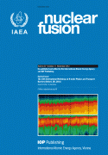
NUCLEAR FUSION
Connecting researchers to the latest breakthroughs in nuclear fusion.NUCLEAR FUSION is a prestigious academic journal published by IOP Publishing Ltd, dedicated to advancing the field of nuclear and high-energy physics. With a significant impact factor and recognized among the top-tier journals, it boasts a Q1 ranking in both Condensed Matter Physics and Nuclear and High Energy Physics as of 2023. This journal, which has been published continuously since 1969, serves as a vital platform for researchers, professionals, and students exploring the latest advancements in fusion energy, plasma physics, and the intricate phenomena associated with high-energy states of matter. By disseminating original research, comprehensive reviews, and interdisciplinary studies, NUCLEAR FUSION strives to foster innovation and collaboration in pursuit of sustainable energy solutions, contributing significantly to the scientific community’s understanding of nuclear fusion processes. While the publication offers access options that enhance its reach, its rigorous peer-review process ensures the highest quality of scholarly communication.

Thermophysics and Aeromechanics
Igniting Innovation in Thermophysics and AeromechanicsThermophysics and Aeromechanics, published by PLEIADES PUBLISHING INC, is an esteemed journal dedicated to advancing the fields of aerospace engineering, energy engineering, modeling and simulation, as well as nuclear and high energy physics. With an ISSN of 0869-8643 and E-ISSN 1531-8699, this journal serves as a vital platform for researchers and professionals working at the intersection of thermophysics and aeromechanics, delivering cutting-edge research, reviews, and case studies. Despite its current position in Quartile Q4 across multiple categories, including aerospace and energy engineering, it provides a unique opportunity for emerging ideas in these domains to gain visibility and impact. The journal's convergence of diverse scientific disciplines is critical for fostering innovation and technological advancements, making it an essential resource for students, practitioners, and academics alike. In this era of rapid scientific development, Thermophysics and Aeromechanics plays a pivotal role in disseminating knowledge and facilitating interdisciplinary collaboration among a global audience.
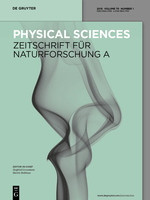
ZEITSCHRIFT FUR NATURFORSCHUNG SECTION A-A JOURNAL OF PHYSICAL SCIENCES
Where Innovation Meets Tradition in Physical SciencesZEITSCHRIFT FUR NATURFORSCHUNG SECTION A - A JOURNAL OF PHYSICAL SCIENCES is a distinguished journal published by Walter de Gruyter GmbH, based in Germany, that serves as a vital platform for research in the realms of mathematical physics, physical and theoretical chemistry, and broader disciplines within physics and astronomy. Established in 1946, this journal has been a cornerstone for scientists and researchers, providing rigorous peer-reviewed articles that push the boundaries of knowledge in physical sciences. With a notable 2023 Scopus ranking reflecting its respected position in the field—Q3 in mathematical physics, physical and theoretical chemistry, and miscellaneous physics and astronomy—this journal not only emphasizes high-quality research but also enhances the visibility and impact of contributions within these areas. Although it does not currently offer open access, the insights shared in its pages are invaluable for advancing academic inquiry and sparking interdisciplinary collaborations. As it looks ahead to 2024, ZEITSCHRIFT FUR NATURFORSCHUNG SECTION A continues to invite contributions that align with its mission to foster an understanding of complex physical phenomena, making it an essential resource for academics, professionals, and students alike.
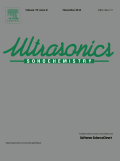
ULTRASONICS SONOCHEMISTRY
Exploring the Synergy of Sound and Chemistry for a Sustainable Future.ULTRASONICS SONOCHEMISTRY, published by ELSEVIER, is a pioneering Open Access journal that has been at the forefront of research in the fields of acoustics, ultrasonics, and their applications in chemical engineering, environmental science, and radiology since its inception in 1994. With an impressive Impact Factor and ranking amongst the top quartile journals across multiple disciplines such as Organic Chemistry, Inorganic Chemistry, and Environmental Chemistry, it serves as an essential platform for researchers and professionals seeking to disseminate their work and advance knowledge in sonochemistry and related areas. The journal's commitment to accessibility since 2021 ensures that high-quality research is openly available, thus fostering collaboration and innovation within the scientific community. As it converges into 2024, ULTRASONICS SONOCHEMISTRY continues to uphold its reputation for excellence and encourages the submission of groundbreaking studies that explore the synergistic effects of ultrasound in chemical processes.

Tungsten
Transforming materials science through tungsten insights.Tungsten, published by SpringerNature, is a prestigious academic journal dedicated to advancing the field of materials science with a specific focus on tungsten and its diverse applications. Launched in 2019, the journal has quickly established itself as a leading resource in its domain, achieving a remarkable Q1 ranking across multiple categories including Materials Chemistry, Materials Science (miscellaneous), Metals and Alloys, and Surfaces, Coatings and Films. With robust performance reflected in its Scopus rankings—holding significant positions such as rank #20 in Metals and Alloys (88th percentile)—Tungsten serves as a vital platform for researchers and professionals seeking to disseminate innovative findings and foster collaboration in the materials science community. Although not an Open Access publication, this journal offers a well-curated collection of high-quality research articles, reviews, and technical notes aimed at driving forward the understanding and application of tungsten in various scientific sectors. Operating out of the United States, Tungsten is committed to providing an essential resource for academia and industry alike, making a significant contribution to the evolving landscape of materials research.
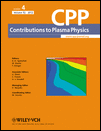
CONTRIBUTIONS TO PLASMA PHYSICS
Exploring the Complexities of Plasma PhenomenaCONTRIBUTIONS TO PLASMA PHYSICS is a distinguished journal dedicated to advancing the field of plasma physics, published by WILEY-V C H VERLAG GMBH. Since its inception in 1988, this journal has provided a platform for high-quality research, fostering collaboration and dissemination of knowledge in the condensed matter physics domain. With its current ranking of Q3 in the 2023 assessments, the journal is recognized for its contributions to the discipline, as indicated by its position in the Scopus rankings (Rank #252/434) and 42nd percentile within its category. Researchers and professionals engaged in plasma physics are encouraged to submit their work, as the journal aims to publish innovative studies that push the boundaries of current understanding and application in plasma phenomena. While currently not offering open access, the journal remains a vital resource for insights into the complexities and advancements in plasma research, operating from its base in Germany.